Wildfire insurance in high fire risk areas.
Living in a high fire risk area, you’re likely to have concerns about wildfire insurance coverage. What are your options? What are the costs? You might worry about whether you can even get home insurance with wildfire coverage in states such as California. Let’s take a deep dive into these issues.
- Are wildfires covered by insurance?
- Wildfire insurance coverage in California.
- What should be included in home insurance protection for wildfires?
- How to get wildfire insurance coverage in high fire risk areas.
- What if your California homeowners insurance is canceled or non-renewed?
- Making a wildfire insurance claim.
- Wildfire insurance coverage FAQ.
- Secure your home with more than just insurance.
Are wildfires covered by insurance?
While you cannot buy stand-alone “wildfire insurance,” several types of policies may provide coverage against wildfire damage.
Does homeowners insurance cover wildfires?
In the past, the answer would be yes, wildfire coverage is included in your home insurance. Today, however, many insurance companies are excluding wildfire coverage from home insurance due to escalating losses and increasing risks.
If you’re wondering whether your homeowners insurance covers wildfires, you can find the answer in your insurance policy documents, which spell out coverage from specific perils. Take a close look at the details.
Most cover your dwelling, other structures on the property like a detached garage or a shed, and improvements such as fences and landscaping. Coverage may spell out what personal belongings are included, as well. Some policies include loss of use, to help you with temporary living expenses while your damaged home is being rebuilt or repaired.
Condo insurance protects the interior of your condo and your personal belongings against fire damage. Your condo policy may also cover living expenses to help you temporarily relocate after a wildfire.
Does renters insurance cover wildfire damage?
Typical renters insurance includes wildfire protection, covering your personal belongings from damage caused by smoke, flames, and water or chemicals used to fight the fire. Some policies also cover temporary living expenses while the damaged property is repaired.
You may have an all-risk policy that covers wildfires, or it may specifically list fire damage as a named peril, no matter the cause. Watch out for coverage limits, exclusions, high deductibles, and overarching policy limits. You’ll want to know your worst-case scenario in advance, so you can find the best policy and be better prepared.
One thing that renters insurance doesn’t cover is your dwelling itself, but your landlord’s insurance policy should cover the structure.
Does car insurance cover wildfires?
Whether your auto insurance covers your vehicle in a wildfire depends on the coverage you buy. Some policies are limited to collision coverage. If you have comprehensive coverage, your vehicle will be covered in the event of a wildfire. Be sure to ask your agent, read your policy carefully, and get answers and clarification—ideally in writing.
Wildfire insurance coverage in California.
California is, unfortunately, the number one state when it comes to homes that are at risk of wildfire damage. According to 2023 statistics, 1,279,214 homes are at extreme risk due to being in fire danger zones. Insurance companies have been increasingly reluctant to cover at-risk homes. In 2018, they declined to cover 179,458 homes. That number rose 31% in 2019, when they dropped coverage on 235,250 homes.
If you manage to find homeowners insurance in fire-prone areas, policy affordability is becoming a problem. With the disappearance of a regular wildfire season, year-round risks are the new normal. And with increasing risk, more insurance companies are denying policy renewal, canceling policies, or removing wildfire coverage from their policies.
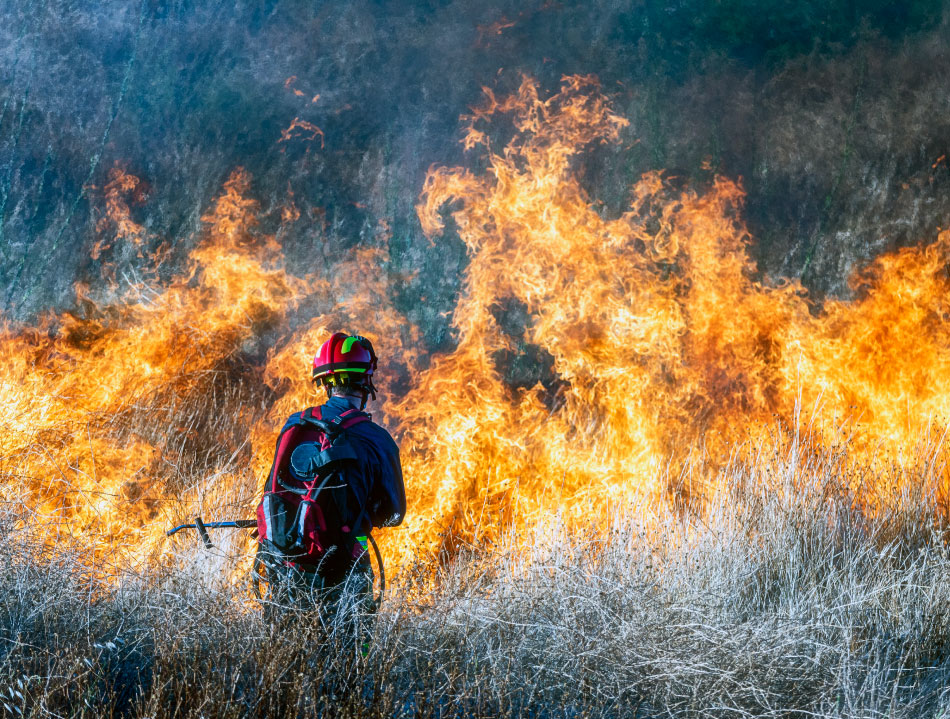
Are insurance companies pulling out of California due to wildfires?
Insurance companies in California are leaving the market due to increasing wildfire risks, more homes being built in areas prone to wildfires, rising inflation, and high construction costs. In 2023, Allstate and State Farm stopped writing new policies, citing the need to manage risks and maintain financial strength. State Farm has canceled 72,000 existing residential and commercial policies in California.Those who are able to get wildfire coverage in California are paying a hefty price. Property insurance premiums rose statewide from $86 million in 2014 to almost $134 million in 2022, according to the National Association of Insurance Commissioners.
What should be included in home insurance protection for wildfires?
Each state approaches regulating the insurance market in different ways. What is normal in Nebraska may not apply in California. When shopping for insurance that covers wildfire damage in California, research the following homeowners insurance considerations before you even ask how much your wildfire insurance coverage costs will be per month.
1. The structure of your home and detached buildings.
To fully cover your property, what is the replacement cost of your home and other structures and fixtures, including sheds, garages, barns, fences, and decks? Your replacement cost is the money it would take to rebuild these structures to their original size and quality, should they be destroyed in a wildfire.
2. Coverage for your personal belongings.
Covering your personal property includes the replacement value of your furniture, appliances, electronics, clothes, and valuables. If you own expensive jewelry, art, wine, or other collectibles, you may purchase a rider that lists these items and their appraised value. You might not think of it as personal property, but your landscaping can also be covered.
3. Your living expenses if your house was destroyed by fire.
helps you pay for temporary accommodations, meals, and other living expenses while your home is being rebuilt can be invaluable.
Loss of use coverage is typically equal to 20% of your dwelling coverage limit. If you live in a fire-prone area, though, you may consider purchasing more loss-of-use coverage. With many people left homeless at the same time, prices for shelter tend to be higher than normal.
4. Liability coverage for others harmed on your property.
Liability coverage protects you from financial claims for medical expenses and property damage for others who have been harmed on your property. In the chaos of a wildfire, it may be difficult for people to make such claims against you, but it doesn’t hurt to have the protection anyway..
How to get wildfire insurance coverage in high fire risk areas.
If you live in a high-risk area and are having trouble finding affordable homeowners insurance, you have a few options for covering your home against fires. High fire risk areas are developments at the edge of urban areas where natural vegetation is abundant, those in higher elevations, and homes in forests. Wherever the Santa Ana winds are strong are some of California’s most at-risk areas.
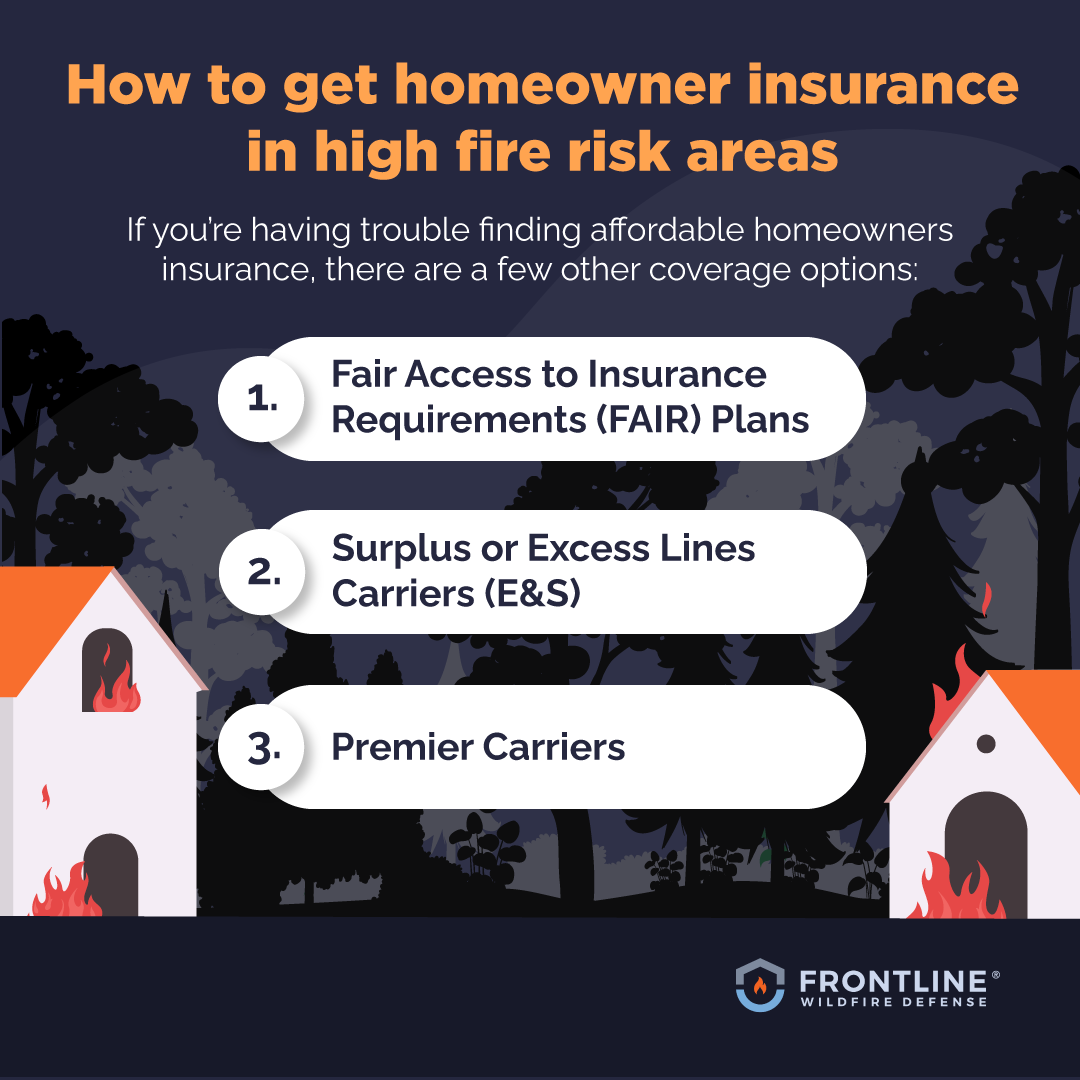
Fair Access to Insurance Requirements (FAIR) Plans.
Plans that make it possible for homeowners to get property insurance, called FAIR Plans, are available in every state. They’re designed for homeowners who have been turned down by insurance companies in the private market due to their home’s location and risk profile. In addition to fire, FAIR Plans cover other hazards, like vandalism and windstorms.
While these plans do offer coverage against fires and other disasters, they often do not cover essentials like liability, medical payments, and loss of use.
FAIR Plans are meant to provide temporary coverage, typically with a cap on the policy amount, and are very expensive. They’re not a good option for high-value homes. Homeowners with a FAIR Plan should continue shopping for insurance in the private market to try to find an affordable, more comprehensive insurance policy.
Surplus or excess lines carriers (E&S).
Surplus or excess line carriers (E&S) are insurance providers that cover risks which standard insurance policies refuse to cover. If you can’t find home insurance through the private market due to your fire risk, this kind of coverage may be an option.
E&S policies are not cheap. E&S insurance premiums rose by 20% between 2021 and 2022, marking the fourth straight year of price increases. While regular homeowners insurance has deductibles around $10,000, E&S policy deductibles start at $100,000 and go up from there.
Despite these costs, this option of last resort may be better than nothing for those who cannot get California home insurance in high fire risk areas.
Premier Carriers.
Premier carriers offer home insurance for high-value and high-risk properties. They may provide additional benefits like fire prevention and firefighting services. To qualify for one of these policies, your home value must exceed a minimum amount.
What if your California homeowner insurance is canceled or non-renewed?
Insurance companies in California are canceling policies or declining to renew them at higher rates than in the past. Finding yourself suddenly without coverage can be frightening and frustrating. But you have the right to wildfire insurance coverage in California, no matter where you live. In the case of a canceled or non-renewed policy, here’s what you need to know.
Can California home insurance policies be dropped due to wildfires?
Losing homeowners insurance coverage is becoming increasingly common for Californians in high fire risk areas. After the governor declared a state of emergency in California, the insurance commissioner issued a “Mandatory Moratorium on Cancellations and Non-Renewals of Policies of Residential Property Insurance.” The moratorium started on September 14, 2023 and goes through September 13, 2024, meaning insurance companies cannot drop your coverage in specified high fire risk areas during this time.
Can insurance companies refuse to renew your policy due to wildfires?
Yes, insurance companies can and do cancel or refuse to renew policies of homeowners in high risk areas. The moratorium is meant to protect you from this.
Without this moratorium, homeowners living near a recent wildfire could have had their policies ended. If your home is in a protected ZIP code, insurance companies cannot cancel your policy until the end of the moratorium.
The moratorium will end in September 2024 if it isn’t extended. We recommend you start researching alternative insurance providers, just in case your policy ends when the moratorium expires. Being ready can prevent gaps in coverage that may leave your assets exposed to risk.
What to do if you lost your California home insurance coverage.
If you’ve lost your California home insurance policy and you live in a high fire risk area, don’t panic. You have options. We recommend taking these steps:
- Contact your insurer immediately. Your insurer or agent may offer actions you can take to lower your risk. If you can document recommended property upgrades, you may be able to keep your policy.
- Look into alternative insurance carriers. You may be able to get a policy from a different carrier. Research your options in advance, to help you be prepared.
- Fireproof your house. Preventing a loss is better than being reimbursed for one, no matter the state of the insurance market. When you install a home fire sprinkler system, like those offered by Frontline Wildfire Defense, you protect your property while also making it easier to secure coverage. Your insurance company may even offer credits or discounts after the system is installed.
- Consider the California FAIR Plan. If all else fails, you may be able to apply for a FAIR Plan. Take the time to learn about this option in advance.
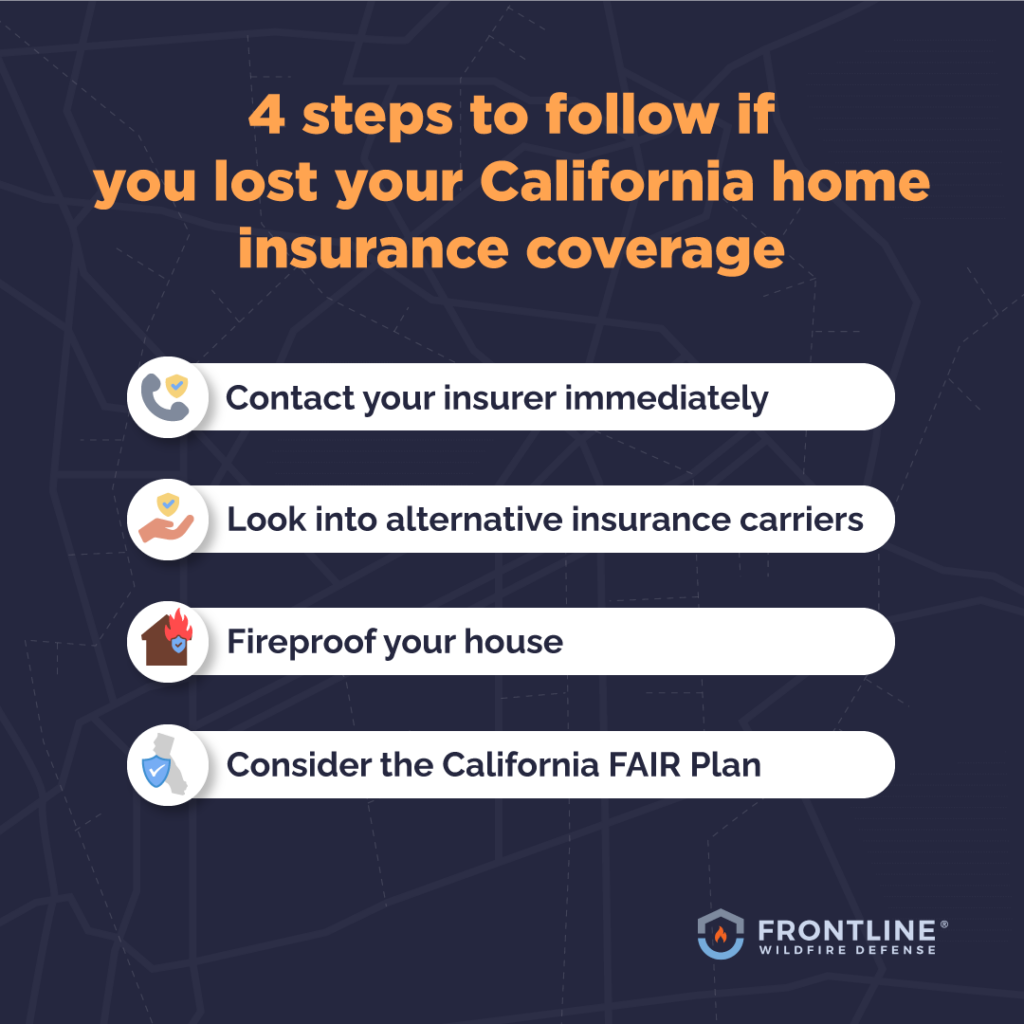
Making a wildfire insurance claim in California.
If you suffer a loss due to a wildfire, it’s important to know what to do to get the greatest benefit from your coverage and to recover as quickly as possible.
- Keep your policy documents in a safe place. You don’t want to lose important documents in a fire. Make sure your policy, birth certificate, property deeds, passports, and other valuable documents are easy to access, should you have to evacuate. Keep secure copies at your place of work or in a safe deposit box at your bank.
- Contact your insurer as soon as possible. The sooner you file your California insurance claim, the sooner you can start rebuilding.
- Take photos and videos of your belongings and interiors to document them in advance. Describe them and, if possible, list their original purchase price. As soon as it’s safe to enter your home, take photos and videos of the damage to structures and belongings. Submit these to your insurer as proof of damage.
- If you have to temporarily relocate after a wildfire, track your living expenses and keep all of your receipts so that you can be fully reimbursed.
- Keep your damaged items for the time being. You may be eager to start cleaning up, but your insurance adjuster may need more detailed proof of damage to document your losses.
- Know your responsibilities and the particulars of your policy. Your insurer may require you to get repair estimates and file claims documents. Don’t put this work off or you could miss getting reimbursed. Most companies have time limits on filing claims, generally 60 days. In the chaos of a loss, it’s easy to miss deadlines, so make this a priority.
- Don’t take no for an answer. If a claim is denied, you can and should appeal. You might not get as much money as you want, but you can often get some. Appeal all denied claims and provide plenty of documentation.
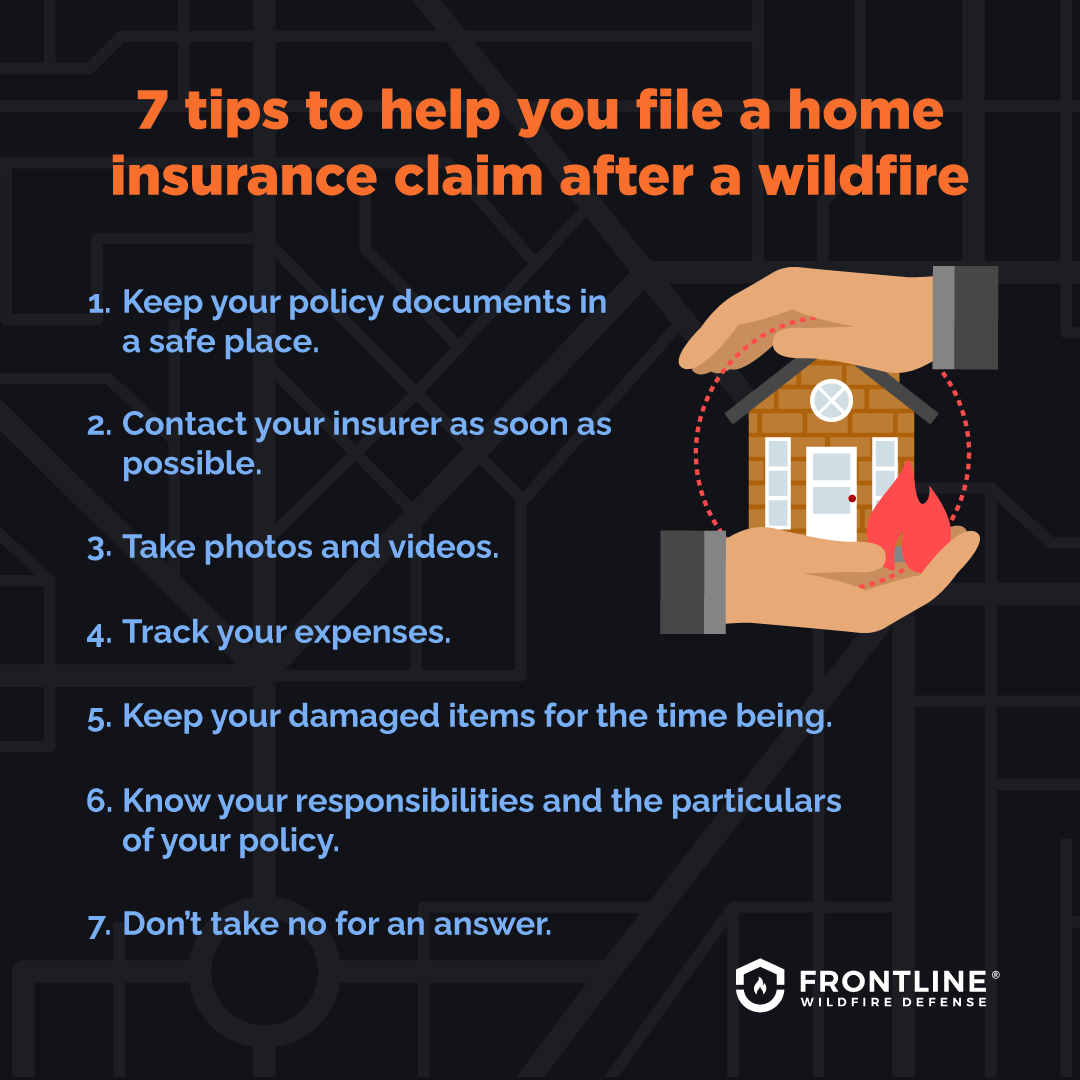
Wildfire insurance coverage FAQ.
How expensive is fire insurance coverage in California?
Prices for homeowners insurance that includes coverage for wildfires in California is determined by several factors, including:
- Location
- Home replacement cost
- Home value
- Coverage limits
- Claims history
- Home safety features
- Age and construction of home
- Estimated wildfire exposure risk
The average premium for homeowners insurance in 2020 was $1,311 per month, and renters insurance came in at $174 per month.
The annual cost of homeowners insurance for residents in fire-prone areas is much higher and has gone up significantly in recent years. In certain areas of California, fire insurance coverage can cost tens of thousands of dollars per year.
As wildfires become more frequent and more severe, insurance rates in fire-prone areas are continuing to increase, leaving many homeowners unable to adequately protect their homes.
Does condo insurance cover wildfires?
Condo insurance typically covers wildfire damage done to your condo’s interior walls. Condo insurance policies often include the following coverages:
- Interior wall coverage
- Personal property coverage
- Additional living expenses coverage
Your homeowners association’s master policy should cover any damages that a wildfire does to the exterior of your condo.
Does hazard insurance cover wildfires?
Yes, fires, including wildfires, are one of the hazards typically covered by homeowners insurance and hazard insurance.
For homeowners in California, this coverage is particularly important as it can help you recover from damage caused by wildfires. Not only can your homeowners insurance policy help repair or rebuild your home, but it can also help you replace your damaged personal belongings and cover temporary living expenses if you’re forced to evacuate your home.
What is a high fire risk home?
Insurers take several factors into account to determine how much of a risk they’re taking on your home. Depending on your risk factors, your home insurance premiums may be very expensive or, in some cases, insurers may refuse to offer coverage at all.
There is no clear definition of a high-risk home, as each insurance company uses its own criteria to assess risk. Most agree that proximity to natural areas increases risk.
For example, if you live in a fire-prone zone and your home is located near a forest, you’ll have a more difficult time finding affordable coverage than someone who lives in the same area but away from any trees, brush, or other fuel sources.
Secure your home with more than just insurance.
Homeowners insurance premiums are rising as more fires create bigger losses for insurance companies. Insurance protects you against financial losses, but it does nothing to actually protect your structure and belongings. Protecting your home from the flames is better than waiting for an insurance payment after you’ve lost everything. That’s why securing your home is about more than just wildfire insurance coverage.
A fire sprinkler system keeps wildfires at bay. Making this investment can save your home and the precious items in it. It can save you money, too. With this added layer of home protection, your insurance company may keep you insured and or even offer you a discounted premium.